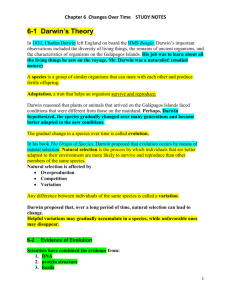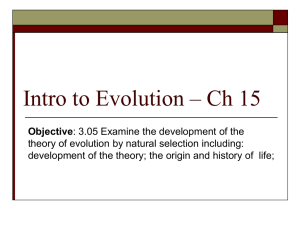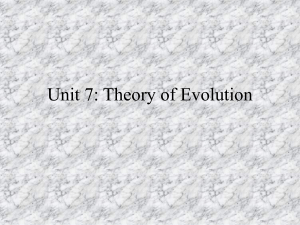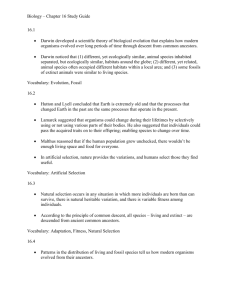Evolution Answers
advertisement
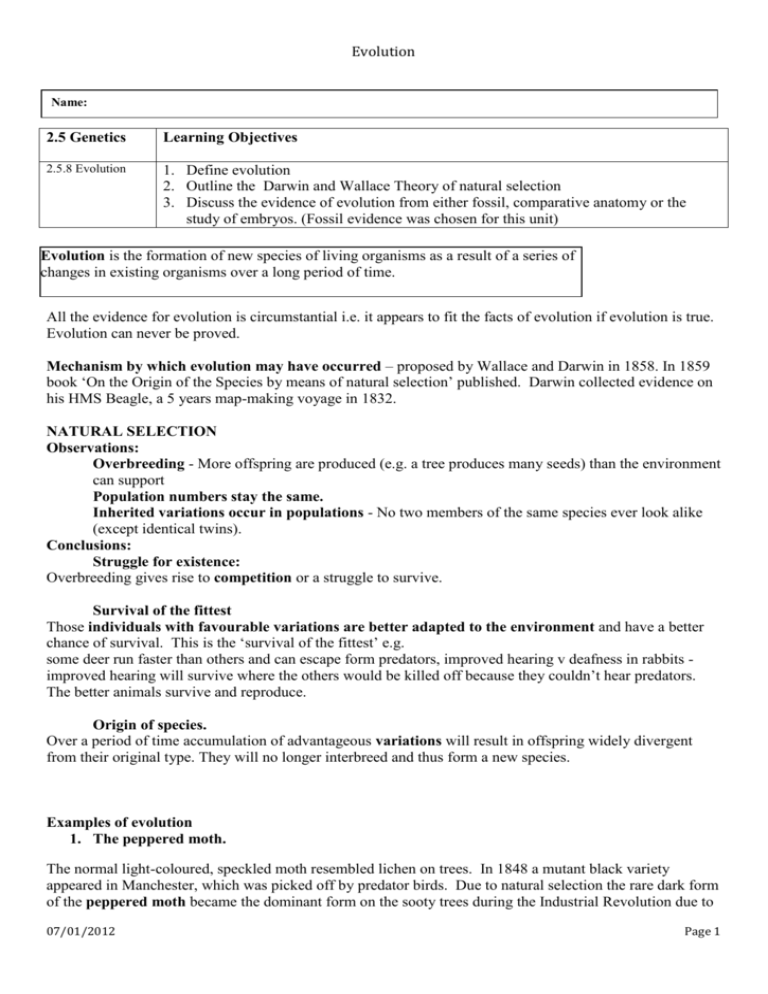
Evolution Name: 2.5 Genetics Learning Objectives 2.5.8 Evolution 1. Define evolution 2. Outline the Darwin and Wallace Theory of natural selection 3. Discuss the evidence of evolution from either fossil, comparative anatomy or the study of embryos. (Fossil evidence was chosen for this unit) Evolution is the formation of new species of living organisms as a result of a series of changes in existing organisms over a long period of time. All the evidence for evolution is circumstantial i.e. it appears to fit the facts of evolution if evolution is true. Evolution can never be proved. Mechanism by which evolution may have occurred – proposed by Wallace and Darwin in 1858. In 1859 book ‘On the Origin of the Species by means of natural selection’ published. Darwin collected evidence on his HMS Beagle, a 5 years map-making voyage in 1832. NATURAL SELECTION Observations: Overbreeding - More offspring are produced (e.g. a tree produces many seeds) than the environment can support Population numbers stay the same. Inherited variations occur in populations - No two members of the same species ever look alike (except identical twins). Conclusions: Struggle for existence: Overbreeding gives rise to competition or a struggle to survive. Survival of the fittest Those individuals with favourable variations are better adapted to the environment and have a better chance of survival. This is the ‘survival of the fittest’ e.g. some deer run faster than others and can escape form predators, improved hearing v deafness in rabbits improved hearing will survive where the others would be killed off because they couldn’t hear predators. The better animals survive and reproduce. Origin of species. Over a period of time accumulation of advantageous variations will result in offspring widely divergent from their original type. They will no longer interbreed and thus form a new species. Examples of evolution 1. The peppered moth. The normal light-coloured, speckled moth resembled lichen on trees. In 1848 a mutant black variety appeared in Manchester, which was picked off by predator birds. Due to natural selection the rare dark form of the peppered moth became the dominant form on the sooty trees during the Industrial Revolution due to 07/01/2012 Page 1 Evolution camouflage (no lichens on bark!). The light-coloured form remained dominant in the non-polluted rural areas - ‘cos living on the light-coloured lichen of the trees. This was due to predation by birds of the conspicuous forms. Now, with ‘Clean Air Act’ normal light variety is common again. This example took place over 50 years (1848 - 1890). 2. Antibiotic resistant bacteria. Bacteria are continuously evolving as they develop resistance to new antibiotics. 3. Warfarin resistant rats. Warfarin is a chemical that interferes with blood clotting. Rats die from excessive haemorrhaging. A dominant allele confers resistance to warfarin. As the use of warfarin spread so too did the number of warfarin resistant rats. One disadvantage for these rats is that they need large amounts of vitamin K. 1. Galapagos Islands Finches. The finches evolved from a common ancestor but developed different beaks for different diets to reduce competition. EVIDENCE FOR EVOLUTION: (STUDY ONE) 1. Fossils (Palaeontology) These are the remains of earlier living organisms (or some indication that something lived along time ago) e.g. bones, teeth, entire organisms, shells, seeds, pollen grains, leafprints, footprints & remains of faeces. They are found in sedimentary rock, ice, amber and in bogs. Rocks and fossils can be accurately dated by radioactive carbon dating (up to about 30,000 years old) and potassium/argon dating (up to 1,200 million years old). The fossil evidence for evolution: (a) The younger fossils are more complex and more similar to modern living organisms. (b) Older eras have fewer types of fossil variety of species was not as great. (c) Present day organisms have no fossils e.g. modern horse. (d) Many fossil organisms not found today (extinct e.g. the dodo and dinosaurs). Evolution of the horse. Observing one trait – height of horse 60 million years ago 0.4 m tall (size of a fox) - eohippus. 30 million years ago 0.6m high (German shepherd height!). 10 million years ago 1m high (Great Dane) 1 million years ago Equus, modern horse = 1.6m tall. The evolution of the horse shows that over 60 million years they have: grown in size; gone from having four toes to walking on a single toe (running on hard ground to escape predators). Molar teeth - from low-crowned for eating soft foliage to hard ridges for chewing grass. The structural changes are related to the different environments they adapted to i.e. marshy wooded areas changing to dry grassland. Natural selection worked causing the extinction of the older less well-adapted forms. 07/01/2012 Page 2 Evolution Fossil record cannot provide a complete description of evolution as: generally fossils are only found for the harder structures of plants and animal. older fossils are difficult to date. many fossils will never be discovered. many fossils are destroyed by erosion. 2. Comparative Anatomy: This deals with the similarities and differences in plant and animal structures. Pentadactyl limb The wing of a bird or a bat, the fore limb of man or monkey or mole and the fin of a whale have the same basic five digit limb structures, but different functions e.g. whale fin (broad, for swimming), arm (long with long fingers and an opposable thumb for lifting and grasping), mole forelimb (stubby, for digging), bat wing (broad, for flying), horse leg (long, for running) and badger leg (stout with long nails, for digging). The different functions show the adaptation of a common structure (adaptive radiation) and descent from a common ancestor. Homologous structures are organs that have the same basic structure, but look different because they have different functions. In some cases structures have been lost as they no longer serve a function e.g. the horse stands on its third toe. Toes two and five are present in vestigial form (miniscule and no useful function), but toes one and five are gone. 3. Comparative Embryology: Embryos of certain vertebrates e.g. human, fish, bird and tortoise have many similarities even though the adult forms are totally different. Similarities include position of brain, tail, notochord, eye and gill slits (= eustachian tube in humans). This evidence again shows that the different embryological structures are inherited from the embryo of a common ancestor. 4. Comparative Physiology and Biochemistry: The theory of a common ancestor leading to the wide variety of present day living organisms can be supported by: the similarity of biochemical pathways e.g. respiration in living cells and similarity of animal blood pigments. Comparisons can be carried out with the DNA or protein structure of each organism. The greater the similarity in their DNA or protein structure the closer they are related. Evolution Section A SEC Sample Paper HL 1. Answer any five of the following. (f) Name a scientist responsible for the Theory of Natural Selection …………………………………………….…………………………………………………… 2009 OL 3. Natural selection is an important aspect of the study of evolution. Answer the following parts in relation to evolution and natural selection. 07/01/2012 Page 3 Evolution (a) What is meant by natural selection? ___________________________________________________ ________________________________________________________________________________ (b) Name a scientist who is associated with the Theory of Natural Selection. ________________________________________________________________________________ (c) Variation is essential for natural selection. Mutation can give rise to variation. Give two causes of mutation. (i) __________________________________________________________________________ (ii) __________________________________________________________________________ (d) Give one source of evidence for the occurrence of evolution.______________________________ _______________________________________________________________________________ Section C 2006 HL 12. (c) Give an account of the Theory of Natural Selection. Name the scientists who are associated with the theory and refer to any one observation that prompted its development. (24) 2011 HL 13. (a) (i) (ii) What is meant by the term evolution? Name either of the scientists responsible for the Theory of Natural Selection. (9) 2013 HL 11. (a) (i) (ii) Give a source of evidence for evolution. Briefly outline the evidence from the source referred to in (i). SEC Sample Paper OL 11. (c) (i) What is meant by the term evolution? (ii) Describe the process of natural selection. (iii) Give an account of the evidence for evolution from a named source. (27) (i) What is meant by evolution? (ii) Name one of the scientists associated with the Theory of Natural Selection. (iii) Give a brief account of the Theory of Natural Selection. (iv) Outline the evidence for evolution from any one named source. (24) 2008 OL 11. (c) 2012 OL 11. (b) 1. What is meant by evolution? 2. Name one of the scientists who first explained how evolution occurs by natural selection. 3. Give one source of evidence for evolution. 07/01/2012 Page 4 Evolution Evolution Answers 2004 HL Sample Q1 1. 5(4) (f) (Charles) Darwin/ (Alfred )Wallace 2009 OL Q3 3. 9 +8 +3(1) (a) Survival of the fittest or explained e.g. best (adapted) survive (b) Darwin / Wallace (c) (i) e.g. Radiation (any 2 examples in i and ii & allow chance) (ii) e.g. Chemicals (d) Fossils / Anatomy / Embryos/ Genetics or example 2006 HL Q12 12. account: high reproductive rate / variation / example / competition / survival / of the fittest / breeding / offspring survive/ traits passed on / those without advantage die out any five Darwin Wallace one observation: large numbers of offspring / low survival / populations constant / variation in offspring / specific example (c) 5(3) 3 3 3 2011 HL Q13 13. (a) (i) (ii) (Inheritable) change within a population (or species) / in response to change in the environment / by natural selection / over time Any 2 Darwin or Wallace 2(3) 3 2013 HL Q11 11. (a) (i) (ii) 2004 OL Sample Q11 (c) (i) 11 07/01/2012 Fossils or embryology or anatomy or adaptation of plant or animal or genetics Any two points from evidence selected above: e.g. Fossils: structure / changing / over time / related to environment e.g. Embryology: different organisms / similar embryo / similar development pathways e.g. Anatomy: Named structure / expansion point Change / producing new organisms / example 3 2(3) 6+3 Page 5 Evolution (ii) 2005 OL Q13 13. (a) organisms have variations / that are inherited / beneficial / will reproduce / struggle for existence / pass on these variation s/ ‘survival / of fittest’ / origin of species Any four (i) A and a (ii) AB Ab aB ab (b) (i) (ii) Any two points 6+3 adenine, thymine, guanine, cytosine or letters A,T,G,C 4(3) three bases / code for one amino acid 3 (iii) information (code) is copied to RNA molecule (iv) (c) 3 ribosome 6 organisms now existing/ have descended from previous types/ by (genetic) change/ natural selection / response to environmental change/ over time any two organisms best suited to environment/ have greater chance of (ii) breeding/ and survive [’survival of the fittest’ = 2(3)] any two (iii) Darwin / Wallace Fossil/series showing change or example/ change related to environment /common descent or ancestry or explained OR Anatomy / homologous structure or bones (or explained)/example of/adaptive radiation (or explained)/example of /common descent (iv) or ancestry OR Embryology/similarity between embryos/ two examples from fish, amphibians, reptiles, birds, mammals/ adult forms different/ common descent or ancestry any two points from one of the above (i) 2008 OL Q11 11. (a) 4(3) 2(3) 2(3) 3 6+6 6,3 (i) (ii) structure found in nucleus/ reference to DNA or genes or hereditary material n / 23 / half of diploid/ single set of chromosomes / contains one of each type or pair of chromosomes / reference to meiosis, gamete, sex cell (b) 9(3) allele – a form of a gene/ types of gene / Bb Dominant -prevents expression of recessive / Bb / stronger / always wins out when present Seán – brown (ii) Máire – red 1. B, b (iii) 2. Bb bb (iv) 50% or 1 in 2 (i) 07/01/2012 Two pts Two pts Page 6 Evolution (c) 4(3) + 2(6) (i) change / producing new organisms / example Darwin / Wallace organisms have variations/ that are inherited/ beneficial / will (iii) reproduce/ struggle for existence / pass on these variations / ‘Survival /of fittest’ / origin of species (iv) fossils/ comparative anatomy/ embryos/ DNA changes/ Horse / bones (ii) Any two Any two 2012 OL Q11 11 (b 07/01/2012 6+3 (iv) 1. Change in a species (over time) or (reference to) natural selection 2. Darwin or Wallace 3. EG. Fossils (3 pts) (v) Absence of melanin / speeds up sunburn or opposite (2 pts) Page 7


